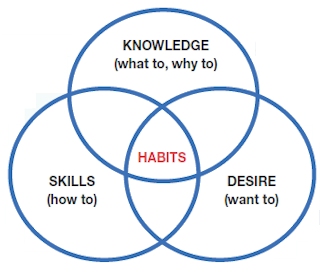Developing Golf Skill s as a Habit
I have recently been reading Dr. Stephen Covey’s bestseller titled The 7 Habits of Highly Effective People, and came across a topic that could be applied to golf instruction. Dr. Covey defines the formation of habit as the intersection of knowledge, skill, and desire.
Given further consideration, it seems this concept could be applied to golf instruction sessions to assess the development of golf skills and a student’s commitment to achieving golf goals. It provides an excellent structure for the teaching professional to evaluate the student’s goal achievement relative to skill-development capacity.
Knowledge represents the fundamental understanding of the golf techniques required to obtain the student’s goal; it is the “what and why” questions. If the student does not possess this knowledge, it will be impossible for them to develop the skills and form good golfing habits. This is a principal area in which the instructor can help move the student up the learning curve. The instructor can use this information to develop a lesson plan for the student based on the lack of knowledge the student has in the particular area.
 Skill represents the “how to” questions that students will need answered before they can develop the skill and form good golf habits. This is the area that instructors will spend the most time with on the range, and will also spend the most time dispelling bad information, as well. Many students come to us with a head full of ideas (courtesy of their golfing buddies) that may not be well founded. We must clear away any confusion or bad information to ensure the student gains the skill based on sound principle and good habit.
Skill represents the “how to” questions that students will need answered before they can develop the skill and form good golf habits. This is the area that instructors will spend the most time with on the range, and will also spend the most time dispelling bad information, as well. Many students come to us with a head full of ideas (courtesy of their golfing buddies) that may not be well founded. We must clear away any confusion or bad information to ensure the student gains the skill based on sound principle and good habit.
The final component to habit formation is desire. Desire represents the golfer’s will-to-do, the drive to set a goal and put the time needed into achieving that goal. It is the most difficult part of being a teaching professional, because we see many students who want quick fixes, bordering on miracles, for their golf games, and we know
they will not have or make the time to practice enough to develop good habits.
It seems to me the intersection of these components of habit is the most important to the teaching professional relative to any student. If we can assess the size of the intersection and the relative size of each component to each other, we can get a better picture of the student profile. As the intersected area becomes larger, the student is developing the knowledge and skill, while the desire to improve is also growing. This is the student who is driven to improve, because they see improvement and are closer to their goal.
We can also use this diagram to describe various student types and give us a clue as to how we should handle them. The student who possesses a large amount of knowledge (the technocrat) is often able to quote every known theory in golf because they have studied every theory.
Unfortunately, in their desire to learn, they have con– fused themselves to the point they can’t comprehend the true fundamentals to work on. It is up to us to clear the fog, so to speak, and help this student to find their way back to basics.
The student with a large amount of skill may be the type who is naturally gifted at sports, or picked up golf early and progressed to some level of success without formal instruction or consideration of the reasons why. This student may have the talent, but doesn’t really know what is going on in their swing, and therefore gets lost when their game isn’t up to normal standards. Something as simple as ball flight laws may be of great help to this person. Unfortunately, the opposite individual may have limited athletic talents and will present a real challenge to the professional, but we must find a way to help them enjoy the game to whatever level they can progress to.
A student with a large amount of desire is a pleasure for the professional to deal with. This student is “hooked” on golf and works hard at it. Some progress very nicely, while others struggle, but all will continue to work at it because they are determined. The opposite of this is the pupil who can’t seem to find the time or doesn’t care to work at it. They are looking for the “secret” that will magically allow them to play with the scratch group on Saturday morning.
There are many variations that can be profiled, but the point is to use this technique to assess students and their goals. From this, we can develop approaches and strategies to help our students attain or modify their goals to realistic expectations. Once realistic goals have been determined, a lesson plan can be developed to lead his student towards their target. This will ultimately lead to a happier student, and a teaching professional satisfied with the effort.




